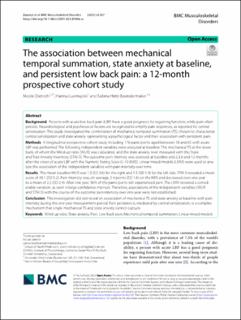Please use this identifier to cite or link to this item:
https://doi.org/10.21256/zhaw-29561Full metadata record
| DC Field | Value | Language |
|---|---|---|
| dc.contributor.author | Dietrich, Nicole | - |
| dc.contributor.author | Luomajoki, Hannu | - |
| dc.contributor.author | Hotz Boendermaker, Sabina | - |
| dc.date.accessioned | 2024-01-12T14:06:55Z | - |
| dc.date.available | 2024-01-12T14:06:55Z | - |
| dc.date.issued | 2023-12-08 | - |
| dc.identifier.issn | 1471-2474 | de_CH |
| dc.identifier.uri | https://digitalcollection.zhaw.ch/handle/11475/29561 | - |
| dc.description.abstract | Background: Persons with acute low back pain (LBP) have a good prognosis for regaining function, while pain often persists. Neurobiological and psychosocial factors are recognized to amplify pain responses, as reported for central sensitization. This study investigated the combination of mechanical temporal summation (TS) chosen to characterize central sensitization and state anxiety representing a psychological factor and their association with persistent pain. Methods: A longitudinal prospective cohort study including 176 participants aged between 18 and 65 with acute LBP was performed. The following independent variables were analyzed at baseline: The mechanical TS at the lower back, of whom the Wind-up ratio (WUR) was calculated, and the state anxiety level measured with the State and Trait Anxiety Inventory (STAI-S). The outcome pain intensity was assessed at baseline and 2,3,6 and 12 months after the onset of acute LBP with the Numeric Rating Scale 0–10 (NRS). Linear mixed models (LMM) were used to analyze the association of the independent variables with pain intensity over time. Results: The mean baseline WUR was 1.3 (SD 0.6) for the right and 1.5 (SD 1.0) for the left side. STAI-S revealed a mean score of 43.1 (SD 5.2). Pain intensity was, on average, 5.4 points (SD 1.6) on the NRS and decreased over one year to a mean of 2.2 (SD 2.4). After one year, 56% of the participants still experienced pain. The LMM revealed a considerable variation, as seen in large confidence intervals. Therefore, associations of the independent variables (WUR and STAI-S) with the course of the outcome pain intensity over one year were not established. Conclusion: This investigation did not reveal an association of mechanical TS and state anxiety at baseline with pain intensity during the one year measurement period. Pain persistence, mediated by central sensitization, is a complex mechanism that single mechanical TS and state anxiety cannot capture. | de_CH |
| dc.language.iso | en | de_CH |
| dc.publisher | BioMed Central | de_CH |
| dc.relation.ispartof | BMC Musculoskeletal Disorders | de_CH |
| dc.rights | https://creativecommons.org/licenses/by/4.0/ | de_CH |
| dc.subject | Linear mixed model | de_CH |
| dc.subject | Low back pain | de_CH |
| dc.subject | Mechanical temporal summation | de_CH |
| dc.subject | State anxiety | de_CH |
| dc.subject | Wind-up ratio | de_CH |
| dc.subject | Human | de_CH |
| dc.subject | Young adult | de_CH |
| dc.subject | Middle aged | de_CH |
| dc.subject | Prospective study | de_CH |
| dc.subject | Anxiety disorder | de_CH |
| dc.subject | Pain measurement | de_CH |
| dc.subject | Rückenschmerz | de_CH |
| dc.subject.ddc | 617.5: Orthopädische Chirurgie | de_CH |
| dc.title | The association between mechanical temporal summation, state anxiety at baseline, and persistent low back pain : a 12-month prospective cohort study | de_CH |
| dc.type | Beitrag in wissenschaftlicher Zeitschrift | de_CH |
| dcterms.type | Text | de_CH |
| zhaw.departement | Gesundheit | de_CH |
| zhaw.organisationalunit | Institut für Physiotherapie (IPT) | de_CH |
| dc.identifier.doi | 10.1186/s12891-023-07046-w | de_CH |
| dc.identifier.doi | 10.21256/zhaw-29561 | - |
| dc.identifier.pmid | 38066474 | de_CH |
| zhaw.funding.eu | No | de_CH |
| zhaw.issue | 1 | de_CH |
| zhaw.originated.zhaw | Yes | de_CH |
| zhaw.pages.start | 957 | de_CH |
| zhaw.publication.status | publishedVersion | de_CH |
| zhaw.volume | 24 | de_CH |
| zhaw.publication.review | Peer review (Publikation) | de_CH |
| zhaw.funding.snf | 173297 | de_CH |
| zhaw.funding.zhaw | Bi-directional interactions of sensory perception, motor performance and fear of movement in the development of persistent low back pain | de_CH |
| zhaw.author.additional | No | de_CH |
| zhaw.display.portrait | Yes | de_CH |
| Appears in collections: | Publikationen Gesundheit | |
Files in This Item:
| File | Description | Size | Format | |
|---|---|---|---|---|
| 2023_Dietrich-etal_The-association-between-mechanical-temporal-summation_BMC.pdf | 964.74 kB | Adobe PDF |  View/Open |
Show simple item record
Dietrich, N., Luomajoki, H., & Hotz Boendermaker, S. (2023). The association between mechanical temporal summation, state anxiety at baseline, and persistent low back pain : a 12-month prospective cohort study. BMC Musculoskeletal Disorders, 24(1), 957. https://doi.org/10.1186/s12891-023-07046-w
Dietrich, N., Luomajoki, H. and Hotz Boendermaker, S. (2023) ‘The association between mechanical temporal summation, state anxiety at baseline, and persistent low back pain : a 12-month prospective cohort study’, BMC Musculoskeletal Disorders, 24(1), p. 957. Available at: https://doi.org/10.1186/s12891-023-07046-w.
N. Dietrich, H. Luomajoki, and S. Hotz Boendermaker, “The association between mechanical temporal summation, state anxiety at baseline, and persistent low back pain : a 12-month prospective cohort study,” BMC Musculoskeletal Disorders, vol. 24, no. 1, p. 957, Dec. 2023, doi: 10.1186/s12891-023-07046-w.
DIETRICH, Nicole, Hannu LUOMAJOKI und Sabina HOTZ BOENDERMAKER, 2023. The association between mechanical temporal summation, state anxiety at baseline, and persistent low back pain : a 12-month prospective cohort study. BMC Musculoskeletal Disorders. 8 Dezember 2023. Bd. 24, Nr. 1, S. 957. DOI 10.1186/s12891-023-07046-w
Dietrich, Nicole, Hannu Luomajoki, and Sabina Hotz Boendermaker. 2023. “The Association between Mechanical Temporal Summation, State Anxiety at Baseline, and Persistent Low Back Pain : A 12-Month Prospective Cohort Study.” BMC Musculoskeletal Disorders 24 (1): 957. https://doi.org/10.1186/s12891-023-07046-w.
Dietrich, Nicole, et al. “The Association between Mechanical Temporal Summation, State Anxiety at Baseline, and Persistent Low Back Pain : A 12-Month Prospective Cohort Study.” BMC Musculoskeletal Disorders, vol. 24, no. 1, Dec. 2023, p. 957, https://doi.org/10.1186/s12891-023-07046-w.
Items in DSpace are protected by copyright, with all rights reserved, unless otherwise indicated.